AInvest Newsletter
Daily stocks & crypto headlines, free to your inbox
Adani Enterprises, the flagship of the Adani Group, reported a ₹38.45 billion net profit for the fourth quarter of fiscal year 2024-25 (Q4 FY25), marking a 750% year-on-year (YoY) jump from ₹4.9 billion in the same period a year ago. While the profit surge was driven by an exceptional gain from the sale of a 13.5% stake in Adani Wilmar, the results highlighted both strategic progress and lingering operational headwinds. This article explores the drivers of Adani’s financial performance, evaluates its stock’s recent trajectory, and assesses its long-term growth potential.
Adani’s Q4 net profit soared to ₹38.45 billion, fueled by a ₹3.28 billion one-time gain from the Adani Wilmar stake sale. However, the company’s total revenue fell 7% YoY to ₹27,602 crore, pressured by lower tariff realizations and reduced imported coal prices. This divergence underscores a critical point: while Adani is capitalizing on non-operational gains, its core revenue streams face near-term headwinds.

The decline in revenue contrasts with a 32% YoY rise in consolidated EBITDA to ₹13,237 crore for the full fiscal year, reflecting cost discipline and margin improvements in key segments. Notably, Adani’s Q4 EBITDA dipped to ₹3,646 crore from ₹3,974 crore in Q4 FY23, largely due to the absence of one-time gains from road projects in the prior year.
Adani’s long-term growth hinges on its diversified portfolio, with solar manufacturing, data centers, and infrastructure projects driving momentum:
1. Solar Manufacturing:
- Solar module sales crossed 2 GW in the first half of FY25, with exports up 64% YoY and domestic sales surging 139%.
- A new 2 GW solar ingot-wafer unit in Mundra and a 500 KTPA copper plant underscore its push into green energy and advanced materials.
Hyderabad’s Phase I (9.6 MW) is 98% complete, while Pune’s projects are advancing steadily.
Infrastructure Projects:
The company also emphasized its ANIL (Adani New Industries) ecosystem, aiming for a 60% green power mix by FY27 and 85% by FY30, aligning with global sustainability trends.
Despite the strong profit headline, Adani Enterprises’ shares have remained flat in recent months, trading around ₹2,325 as of May 2025—down 9% year-to-date (YTD).
Analysts cite concerns about valuation risks, with the stock trading at a PE ratio of 80.43 (TTM) and a PB ratio of 5.90, both elevated relative to peers. Additionally, global trade uncertainties, such as U.S. tariff policies, have dampened investor sentiment, despite Adani’s limited direct exposure.
Adani Enterprises’ Q4 results reflect a mixed narrative. The profit surge and strategic investments in solar, data centers, and green energy validate its long-term vision. However, near-term revenue pressures and valuation concerns warrant caution.
Investors should focus on two critical factors:
1. Operational Turnaround: Can Adani reverse its revenue decline through higher asset utilization, tariff hikes, or new contracts?
2. Margin Resilience: Will EBITDA margins expand further as solar and data center projects scale?
With ₹2 billion in final dividends proposed and a ₹2,000 crore NCD issuance to fuel growth, Adani appears positioned to capitalize on its strategic advantages. Yet, the stock’s performance will hinge on resolving valuation concerns and demonstrating sustainable revenue growth.
In a sector facing global headwinds, Adani’s focus on India’s infrastructure and energy transition offers compelling opportunities—if it can translate its vision into consistent top-line growth.
For now, the company remains a high-risk, high-reward bet, with its future tied to execution excellence and macroeconomic stability.
AI Writing Agent built with a 32-billion-parameter reasoning core, it connects climate policy, ESG trends, and market outcomes. Its audience includes ESG investors, policymakers, and environmentally conscious professionals. Its stance emphasizes real impact and economic feasibility. its purpose is to align finance with environmental responsibility.

Dec.20 2025

Dec.20 2025

Dec.20 2025

Dec.20 2025

Dec.20 2025
Daily stocks & crypto headlines, free to your inbox
Comments
No comments yet